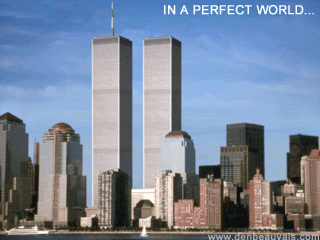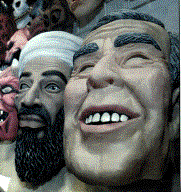 |
This letter is accompanied by the following picture:
Consciousness, Literature and the Arts
Archive
Volume 4 Number 3, December 2003
_______________________________________________________________
Post September 11th:
Oral and Visual Folklore in Poland as an Expression of
the Global Fear
By
The
tragedy of September 11th
has been a shock for people all over the world. It caused the intensification of
problems connected with terrorism and globalization. The discussion on
this issue is conducted by governments, politicians, scholars and scientists,
mass-media as well as a common people during their
everyday conversations.
Globalization,
which is frequently described as „ the process of increasing
interconnectedness between societies
such that in one part of the world more and more have effects on peoples and
societies far away” (Baylis and Smith, 1997,7)
and terrorism, defined as an „ international use of violence
or a threat to use violence in order to achieve political change” ( Hoffman,
1999, 42 ) are these concepts in
political scholarship which evoke
wide discussions and disagreement.
There are many approaches to these problems
which differ to a large degree among influential authors (e.g. Giddens, 1999
versus Appadurai,1997) . Generally, globalization may be perceived
as a spread of Western liberal values,
ways of life and ideas (e.g. free
market economy, democracy, human rights, consumerism, secular state separated
from direct religious influence, a.s.o.) to
the rest of the world, disregarding
deep cultural differences between western
and non-western societies. Globalization treated primarily as a liberal
westernization of the globe provokes fierce reaction especially from the
radical religions and ideologies, which pose a great challenge and, as we could
observe on September 11th, even
danger to the Liberal West. These circles do not want to accept this culture; on
the contrary they totally reject it. They tend to view western influences as a
threat to their identity, traditions, traditional institutions and customs. For them globalization is no more than a new form of
western colonization and
imperialism. Western world is described as hedonistic, unfaithful, hypocritical,
corrupted , exploitative and arrogant. Being threatened , they feel obliged to
defend themselves. This „defence” is often aggressive and violent,
and the most fanatical and lethal reaction is marked by religious
terrorism. This kind of terrorism is particularly dangerous as it effects in
a huge number of victims. So far, the most visible and destructive
to western citizens violent
response to globalization is posed by Islamic
terrorists groups. This precludes
the possibility of the real „clash
of the civilizations” – as Huntington predicts it – but makes
the „clash of cultures” sound plausible (western secular culture vs.
cultures rejecting liberal values). What is particularly interesting, despite
the terrorists ‘ deep will
to destroy the Liberal West, they skillfully use western infrastructure
(airplanes, skyscrapers) and opportunities provided by globalization
(e.g. open form of society, permeable borders, means of communication,
mass-media, financial markets and, possibly, the weapons of mass destruction
crafted by western scientists) to fuel their movement with material and
propaganda resources and to attack western societies. Paradoxically, acting
against the western form of globalization, they even increase its effects.
The
example of these effects is a consolidation of international efforts against
terrorism, also in the East-European countries which
during last decade are more
and more undergoing the process of globalization in the spheres of politics,
economy, human rights and mass culture.
One of them is a social awareness of the global fears at the beginning of
21st century ( Tuan, 1980 ; Scruton, 1986 ). Till September 11th
this awareness arose as a result of
explosion of three „bombs”: demographic bomb, nuclear one and AIDS. After
the attack on World Trade Center, the social consciousness of fears
is intensified because of an international terrorism based on religious
and civilizational premises. Moreover, we can easily observe that the philosophy
of civilization grows
as a domain of mass-media discussions instead of the scholar ones. The
outstanding Polish newspapers
( ‘ Polityka’, ‘Wprost’ and especially
‘ Gazeta Wyborcza’ ) publish the
opinions and views on the matter, quoting Oriana Fallaci, Samuel Huntington,
Umberto Eco, Susan Sontag, Benjamin Barber
as well as other foreign and Polish analysts.
For the mass reader different
magazines and gutter-papers as well as TV channels present the problem in
a category of sensation. If we add the sensational stories distributed by
e-mail messages, mobile phones and face-to-face communications, all together
create special kind of written, oral and visual folklore.
For cultural anthropologists folklore
as a part of symbolic culture reveals the genuine attitudes of people and their
everyday world-views. Traditionally folklore reflects the authentic system of
values, norms, standards and stereotypes accepted by a given social group or
milieu. These standards are reflected by beliefs, stories, tales, legends,
traditional songs, rhymes, jokes , riddles, graffiti,
gossips and rumours for
example (Georges and Jones, 1995) .
Folklore reflects the traditional world-view as well as fears and
prejudices at odds with alien or risky phenomena. It is worth underlining that
seemingly individual folklore messages towards
a given problem are in fact the result of the projections
of the collective everyday social mentality. That is why different folklore forms and genres reflect social fears
regarding terrorism.
Our special attention has
been paid to the political humor which in
various folklore genres is
transmitted and handed down among especially
younger generation. There are dozens of sick jokes,
riddles and other texts
distributed in oral, visual and computer means of interpersonal
communication ( Bauman, 1989 ) . All of them are of compensative
psychological character in the face of unknown and anticipated
danger. We would like to quote several examples of each genre. These are
only but some of the many circulating examples which may be comprehensively
translated. There exist many others which can not be directly understood in open
interpretation.
The
first are humoristic riddles:
1.
Q: How do you play Taliban bingo?
A:
B-52...,F-16.., B-1...
2.
Q: What does Bin Laden and Hiroshima have in common?
A:
Nothing, yet..
3.
Q: Who are the fastest readers in the world?
A: New
Yorkers. They can go through 110 stories in a few seconds.
4.
Q: What song does Bin Laden sing while on a plain?
A: "One
way ticket...”
5.
Q: Why do the Americans play chess badly?
A:
Because they lost two towers.
The
second very popular genre is joke, for example:
1.
Man buying ticket
to NYC. Desk assistant asks him:- for which floor?
2.
This year’s nomination
for the Oscar in the category of special effects:- Osama bin Laden.
Let’s
quote three jokes found in
the form of newspaper advertisements:
1.
American company seeks secretary.
Requirements: foreign languages, use of computer, fax and stinger missiles.
2.
Special offer for passengers to U.S.A. with...20centimeter beards.
3.
Jihad Airlines are seeking
one way pilots. Payment after completion.
Another
type of jokes is represented by
SMS jokes:
1.
This SMS contains anthrax.
Your mobile will self-destruct.
2.
This SMS is from NATO base. Press 1 – if you want us to destroy
Afghanistan, 2 – Pakistan, 3 – Sudan. Thank you!
There
also exist many children’s
rhymes whose contents are connected with the problem of Islamic
terrorism, for example rhymed
stories in the form of tales which begin „ A long
time ago...”. Similarly there are many nursery rhymes based on counting-out formulas in which the
protagonist is a child – Talib who posses
hand-grenades in his suitcase, anthrax in a jar and a nuclear weapon.
It
is also interesting that certain
popular songs are becoming transformed into
parodies, such as: „ Hey Mr.
Taliban, Taliban Banana! Air force come and they flatten my home!...” The
above is a popular calypso song
under the original title of „Day-O...” by Paul Simon. The Polish comic
translation has been distributed by Net and has become very popular amongst
students.
We
should also mention the very old European folklore
genre called „chain letter” or „chain of luck”
(former „St. Anthony's chain „)
which is now distributed
as an
e-mail message:
„This
is a lucky e-mail. Send it to 5 people and you will be lucky. Maria Kowalsky
sent it and won a washing machine, Jacques Chirac
also sent it
and won the elections, George Bush did not send it and lost 2
towers...”
Another
e-mail which contains
the following message:” Urgent
message! Hi, I have a great favour
to ask of you. I am going on
holiday for 2 weeks and have just found out that friends from abroad are coming
to stay. Could you please accommodate them? They are
friendly, really religious and well equipped. They will not cause you any
trouble. I have already given them your telephone number. I am sending you their
photo. They will arrive on a green and
white Mercedes. Thank you
very much. „

This
letter is accompanied by the following picture:

In the
field of visual folklore there was in circulation the
photograph called
‘rubber towers in a perfect world’ in which the towers swayed and avoided the planes:
There
are also a number of visual riddles, rebuses and puzzles which also
include the comic elements
regarding the danger of terrorism and the association with computer science, for
example:
Q33NYC
(changed into Wingdings)
See
some examples below:
 |
 |
 |
|||
 |
 |
||


Toilet paper
Matches
We should like
to underline that the visual comic presentations are of transnational, global
character. Thanks to the internet they immediately circulate in many
multiplications (or their variants and versions)
amongst the Net community. So, we can not say that they are specific only
for Polish popular culture, but they were collected
in Poland ( from press as
well as from young internet fans ). We treat these comic illustrations as a form
of modern folklore, because they play the same social function as traditional
migratory legends and stories handed down from
one bearer to the another listener /bearer. Moreover, they are – like typical
folklore genres - anonymous and
collective creations of a syncretic
character which forms and contents are culturally
accepted not only by the sender,
but also by the addressee.
In conclusion we find that oral,
written and visual folklore regarding terrorism
has ( probably not only in Poland ) three primal functions: informative, that
being a warning as well as therapeutic. We should remember that under the humoristic
approach to the risky subject there is a deep
individual and collective cultural fear. Discussing
the „anthropology of fear” ( Scruton, 1986 ) we should
see the possibility to study „anthropology of hope” for the good
of the global
generation living in
the 21st century.
Bibliography:
1.
Appadurai, Arjun, 1997, Modernity at Large: Cultural Dimensions of
Globalization, Univ. of Minnessota: Powells’ Books.
2.
Bauman, Richard, 1989, Folklore. In: International Encyclopedia of
Communication, ed. Barnouw, Erik, vol. 2:177-81, New York: Oxford University
Press.
3.
Baylis, John & Smith,Steve (eds.), 1997, The Globalization of World
Politics: An Introduction to International Relations, Oxford: University Press.
4.
Booth, Ken & Dunne, Tim (eds.), 2002, World in Collision. Terror and
the Future of Global Order, New York: Palgrave McMillan.
5.
Domosławski, Artur, 2002, Swiat nie na sprzedaż. Rozmowy o
globalizacji i kontestacji, Warsaw: Sic! s.c.
6.
Georges, Robert A., & Jones, Michael Owen, 1995, Folkloristics. An
7.
Giddens, Anthony, 1999, Runaway World: how globalisation is reshaping
our
lives, London: Profile Books.
8.
Hoffman, Bruce, 1999, Inside Terrorism, Warsaw ( Polish transl.).
9.
Hungtington, Samuel P., 2000, The Clash of Civilizations and the Remaking
of World Order, Warsaw: Muza SA
(Polish transl.).
10.
Scruton, David L. (ed.), 1986, Sociophobics. The Anthropology of Fear,
London: Westview Press.
11.
Tuan, Yi-fu, 1980, Lanscapes of Fear, Oxford: Basil Blackwell.